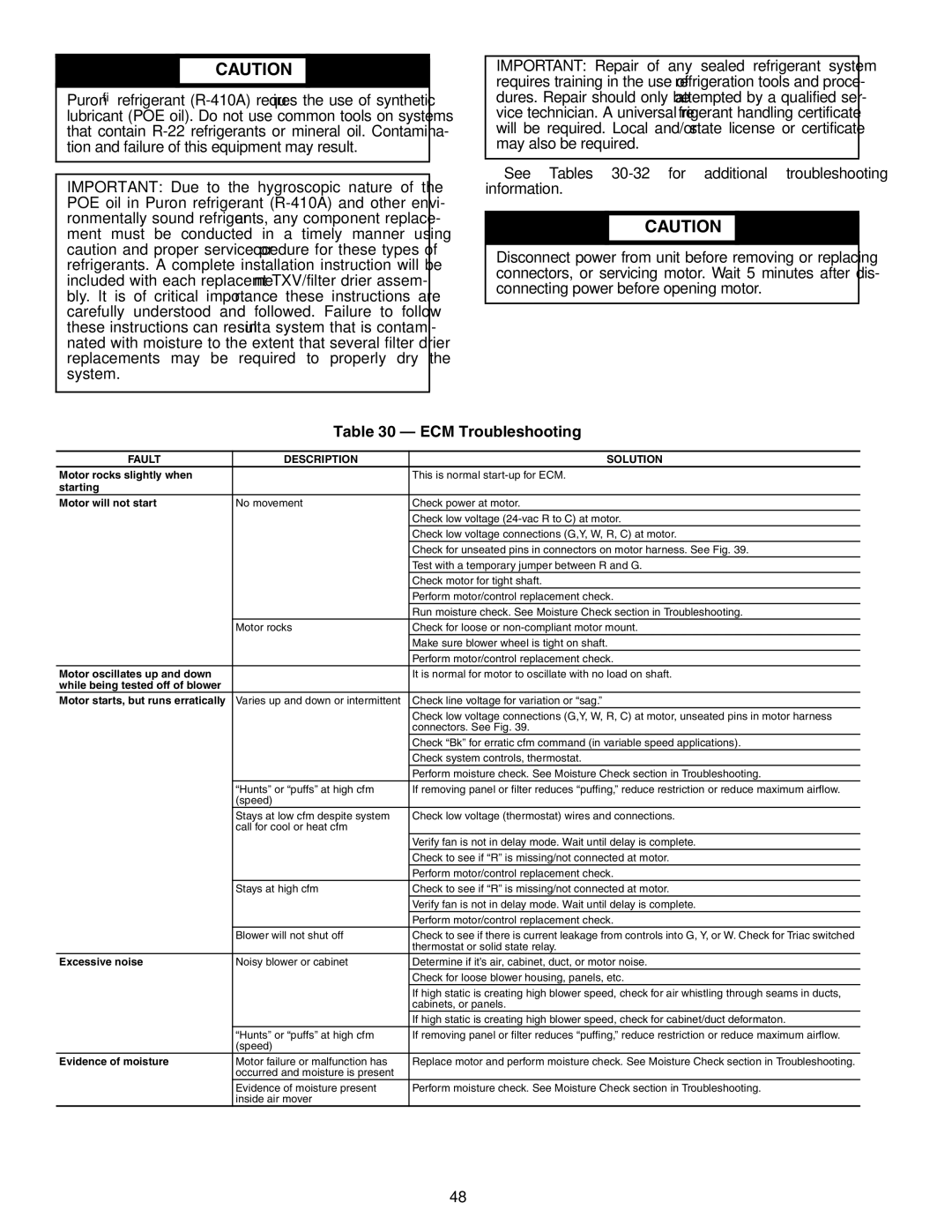
![]() CAUTION
CAUTION
Puron® refrigerant
IMPORTANT: Due to the hygroscopic nature of the POE oil in Puron refrigerant
IMPORTANT: Repair of any sealed refrigerant system requires training in the use of refrigeration tools and proce- dures. Repair should only be attempted by a qualified ser- vice technician. A universal refrigerant handling certificate will be required. Local and/or state license or certificate may also be required.
See Tables
![]() CAUTION
CAUTION
Disconnect power from unit before removing or replacing connectors, or servicing motor. Wait 5 minutes after dis- connecting power before opening motor.
Table 30 — ECM Troubleshooting
FAULT | DESCRIPTION | SOLUTION |
Motor rocks slightly when |
| This is normal |
starting |
|
|
Motor will not start | No movement | Check power at motor. |
|
| Check low voltage |
|
| Check low voltage connections (G,Y, W, R, C) at motor. |
|
| Check for unseated pins in connectors on motor harness. See Fig. 39. |
|
| Test with a temporary jumper between R and G. |
|
| Check motor for tight shaft. |
|
| Perform motor/control replacement check. |
|
| Run moisture check. See Moisture Check section in Troubleshooting. |
| Motor rocks | Check for loose or |
|
| Make sure blower wheel is tight on shaft. |
|
| Perform motor/control replacement check. |
Motor oscillates up and down |
| It is normal for motor to oscillate with no load on shaft. |
while being tested off of blower |
|
|
Motor starts, but runs erratically | Varies up and down or intermittent | Check line voltage for variation or “sag.” |
|
| Check low voltage connections (G,Y, W, R, C) at motor, unseated pins in motor harness |
|
| connectors. See Fig. 39. |
|
| Check “Bk” for erratic cfm command (in variable speed applications). |
|
| Check system controls, thermostat. |
|
| Perform moisture check. See Moisture Check section in Troubleshooting. |
| “Hunts” or “puffs” at high cfm | If removing panel or filter reduces “puffing,” reduce restriction or reduce maximum airflow. |
| (speed) |
|
| Stays at low cfm despite system | Check low voltage (thermostat) wires and connections. |
| call for cool or heat cfm |
|
|
| Verify fan is not in delay mode. Wait until delay is complete. |
|
| Check to see if “R” is missing/not connected at motor. |
|
| Perform motor/control replacement check. |
| Stays at high cfm | Check to see if “R” is missing/not connected at motor. |
|
| Verify fan is not in delay mode. Wait until delay is complete. |
|
| Perform motor/control replacement check. |
| Blower will not shut off | Check to see if there is current leakage from controls into G, Y, or W. Check for Triac switched |
|
| thermostat or solid state relay. |
Excessive noise | Noisy blower or cabinet | Determine if it’s air, cabinet, duct, or motor noise. |
|
| Check for loose blower housing, panels, etc. |
|
| If high static is creating high blower speed, check for air whistling through seams in ducts, |
|
| cabinets, or panels. |
|
| If high static is creating high blower speed, check for cabinet/duct deformaton. |
| “Hunts” or “puffs” at high cfm | If removing panel or filter reduces “puffing,” reduce restriction or reduce maximum airflow. |
| (speed) |
|
Evidence of moisture | Motor failure or malfunction has | Replace motor and perform moisture check. See Moisture Check section in Troubleshooting. |
| occurred and moisture is present |
|
| Evidence of moisture present | Perform moisture check. See Moisture Check section in Troubleshooting. |
| inside air mover |
|
48
